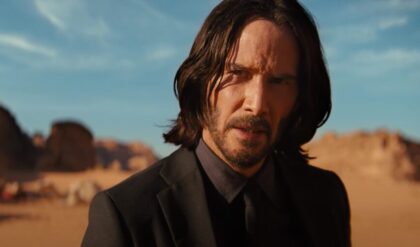
Concocting the perfect gangster movie is harder than it looks. “Don’t ever take sides with anyone against the family,” and “Don’t get high on your own supply,” are lines that immortalized The Godfather and Scarface in the crime genre and pop culture. There’s a reason that three of four guys mastered the mob-movie recipe when everyone else desperately tried to imitate the tropes and concepts they perfected, taking notes. 1995’s Get Shorty, on the other hand, was so well-regarded for parodying Hollywood, subtly winking at the audience. The gangster angle was a nice extra pulled off brilliantly. However, the film is at heart a Hollywood movie, in the vein of The Player.
Barry Sonnenfeld’s film was part of the revival of John Travolta’s persona, allowing the actor to finally land a meaty role that accommodated his swagger after a decade lost in family B-comedy limbo. Based on a 1990 Elmore Leonard novel, it did justice to the dialogue. That’s no small detail, as we’ll soon explain. The crime comedy was also part of a golden era of action comedies, insinuating a mob enforcer would fit right in with the power brokers, scummy agents, vain producers, and wannabe tough guys in Los Angeles. Our hero, Chili Palmer (John Travolta), is charming yet convincing, eyeing the movie industry as a worthwhile spot to stake a claim for his own activities.
The sequel? Well, let’s just say nobody talks about that one, and for good reason. This iteration of the Chili Palmer saga, played once again by Travolta, falls short in every regard except budget. When it comes to Travolta in crime movies, he’s a hit-and-miss kind of guy. For every Swordfish and Pulp Fiction, there is a Gotti and Be Cool. The edge is gone here. Be Cool gets almost everything wrong, most notably the organized crime vibe. New director F. Gary Gray was tapped to direct this sequel but was up against factors no one could realistically overcome.
The Dreaded PG-13 Rating

Before the cameras rolled, the film was already doomed. Rising to fame on the success of Friday, and The Italian Job remake, this film would derail the otherwise impressive career of Gray, a directing resume that didn’t fully get back on track until he released Straight Outta Compton in 2015.
Critics nitpicked the movie for various flaws, but the lasting negative reputation is deserved. It was especially misguided for not understanding why the genre works, and further, for not fully grasping why the first film in this series won over moviegoers. Gray owned up to the film’s mistakes, citing the fact it was altered before shooting to secure a more bankable PG-13 rating, the death knell of any mobster film. The film was kneecapped, the director lacking the final say in anything, Gray told Deadline in 2015:
This was a movie about shylocks and gangsta rappers and if you can’t make that world edgy, you probably shouldn’t do it. I walked in thinking I was going to make one movie and then it changed. Maybe it was arrogant of me to think because I had success in this realm of PG-13 I could make that work.
In one of the savviest moves of his career, Travolta battled to keep Leonard’s dialogue and soul alive in the first movie, refusing to participate in the movie unless the producers had all the meatiest lines returned, sensing that the adaptation was dead in the water unless it adhered to the book and earned that R-Rating, as per Time. His suspicions were proven correct, the film making back its budget and then some, regardless if the cast dropped an F-bomb … or fifty. No amount of lobbying could salvage Be Cool. Does a mob movie need violence and obscenity every thirty seconds? Probably not, but it sure doesn’t hurt. You have to get the atmosphere right, first and foremost, capiche?
A Mobster Movie that Doesn’t Understand Mobsters

After washing out Travolta’s mouth with soap, the producers were left with a very different tale than what was on the page. The slapstick comedy approach didn’t mesh with the tone of the first movie. As a comedy, it might elicit a chuckle or two depending on your tastes, but as a crime film, it doesn’t make much sense. Criminals are always looking to diversify. The crime genre is arguably the master of illustrating the paranoia of the criminal lifestyle, with every iconic gangster on the lookout for hostile takeovers.
What Be Cool disregards, is that they only do it for the money. Most mafia businesses are, in fact, fronts, disguising the source of illegal money from gambling, drugs, and more. For a lesson in Money Laundering 101, look no further than Leo Getz, as played by Joe Pesci in the Lethal Weapon franchise, shuffling money to disguise illicit gains from mafia dealings. An entire routine in Goodfellas dwells on the folly of making flashy purchases, most notably mink coats and pink Caddies. The thing about real mafia kingpins is that they wish to fly under the radar, not alert the authorities about their business deals.
Scorsese understood that a criminal racket at the end of the day is still a business. In an early scene in Goodfellas, Henry Hill torches his own restaurant to collect the insurance payout. In the 1990 crime biopic Bugsy, we see the deadly ramifications of a mafia feud over control of a business enterprise. To a real wise guy, none of these investments mean a thing other than to fill their pockets with the quickest buck.
Chili risking his life and fortune to break into the music industry and save a young ingénue out of the kindness of his heart and love of the arts seems antithetical to everything the mob actually stands for. Whatever you might say about the third Godfather installment, it was smart enough to know that no one actually wanted to see a legal and reformed Michael Corleone hawking Corleone-brand olive oil. They wanted murder, felonies, and mayhem.
Outdated Tropes and Wasted Talent
In a three-year window in the mid-’90s, as seen in Jackie Brown and Out of Sight adaptations, Leonard’s work popped up as the go-to source for neo-noir scripts, taking an unexpected route that managed to walk the line between comedy, romance, and drama. Be Cool put a damper on that hot streak, regardless of the supporting roles filled by Dwayne Johnson, Vince Vaughn, Harvey Keitel, James Woods, Cedric the Entertainer, and Danny Devito.
It’s oft said that the best fiction imitates life. This genre can succeed by evolving the established themes or sharpening them. Be Cool doesn’t do either. Instead, it relies on a lot of caricatures and self-references that fall flat, as seen in the Pulp Fiction recreation, itself a reference to Travolta’s Saturday Night Fever. It works in Pulp Fiction because, in Tarantino’s film, it’s a clever callback, in a film built upon allusions to other movies.
Sonnenfeld’s first entry in the series was compared to classic noir for its exploration of the seedy side of Hollywood. Here it’s desperate fan service in a film that has a little of everything tossed into the blender and puréed into an easily digestible paste, cramming as many names on the marquee as the producers could recruit.
Dwayne Johnson plays against type but is wasted on a one-note character who gets less funny each time you see him on screen, the entire punchline being that he’s gay and a terrible bodyguard pretending to be a tough guy, a weaker variation on James Gandolfini’s bungling character from Get Shorty. The Vince Vaughn character at no point ever feels like a character that could exist in real life nor is a tangible threat.
Forced Humor

There’s a way to incorporate humor into a mobster film or TV show, black humor central to classics like The Sopranos, enhancing the realism. Be Cool is more like a sitcom. This is a stark contrast to Sonnenfeld’s pitch to a reluctant Gene Hackman prior to shooting Get Shorty, where he said: “Don’t be in a comedy. Don’t play it as a comedy, play it as reality. Let the audience decide it’s a comedy.”
If the movie gets one thing wrong, it’s the fact that a mob guy would take a special interest in making great art and fostering artists. Mafiosos have long indulged in entertainment, that much is spot on. Get Shorty featured a shady horror director who made disposable trash. In Be Cool Palmer is a budding mogul. It should be noted that Leonard, a guy from Detroit who rose to fame writing Westerns, wasn’t really intimately familiar with the mafia or gangsters.
Research aside, he didn’t possess the same understanding of the ins and outs of the music industry as he did about haggling with movie execs, scriptwriters, financiers, and directors, which he had been doing for many decades. Funny enough, Leonard admitted to Charlie Rose that he wrote the book Be Cool only because MGM informed him they needed another Chili Palmer book to adapt, which also explains why Aerosmith is awkwardly shoe-horned into a film about RnB and gangsta rappers. What a shock.








